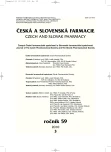Influence of the kind of polymer on chlorhexidine liberation from hydrogel
Authors:
Z. Vitková; M. Žabka; P. Herdová
Authors‘ workplace:
Univerzita Komenského Bratislava, Farmaceutická fakulta, Katedra galenickej farmácie, Slovenská republika
Published in:
Čes. slov. Farm., 2010; 59, 123-126
Category:
Original Articles
Overview
The aim of this paper was to select the optimal polymer for the formulation of the model drug chlorhexidine dichloride into hydrogel. Two types of biopolymers were used, one of the modified polymers was of herbal origin taken from the group of cellulose derivates – methylcellulose, hydroxyethylcellulose and hydroxypropylcellulose, and the other was of animal origin – chitosan of a medium and a high molecular weight. The polymers were used in a concentration of 2.5% (m/m). Drug liberation was evaluated by the percentage of the drug released into the physiological solution. In addition, the rheological properties of hydrogels were evaluated. Judging the drug release from chitosan hydrogels, the one with the medium molecular weigh was found to be optimal. Contrary to that, from among the hydrogels prepared on the basis of cellulose derivatives, the optimal one was hydroxyethylcellulose hydrogel.
Key words:
chlorhexidinedichloride – polymers – hydrogel – liberation – rheological properties
Sources
1. Hirsh, S. G., Spontak, R. J.: Temperature – dependent property development in hydrogels derived from hydroxypropylcellulose. Polymer, 2002; 43, 123–129.
2. Ramachandran, S., Chen, S., Etzler, F.: Rheological charakterization of hydroxypropylcellulose gels. Drug Dev. Ind. Pharm., 1999; 25, 153–161.
3. Sinha, R. D., Rohera, B. D.: Comparative evaluation of rate of hydration and matrix erosion of HEC and HPC and study of drug release from their matrices. Eur. J. Pharm. Sci., 2002; 16, 193–199.
4. Rafiee-Tehrani, M., Mehramizi, A.: In vitro release studies of piroxicam from oil-in-water creams and hydroalcoholic gel topical formulations. Drug Dev. Ind. Pharm., 2000; 26, 409–414.
5. Vitková, Z., Šubová, M., Zbudilová, J., Cirbusová, E., Čižmárik, J.: Hodnotenie farmaceutickej dostupnosti nesteroidného antireumatika z hydrogélov. Farm. Obzor, 2003; 72, 197–200.
6. Fujii, M., Shiozawa, K., Watanabe, Y., Matsumoto, M.: Effect of phosphatidylcholine on skin permeation of indometacin from gel prepared with liquid paraffin and hydrogenated phospholipid. Int. J. Pharm., 2001; 222, 57–64.
7. Rabišková, M.: Moderní lékové formy pro orální a perorální aplikaci. Bratislava: Farmaceutická fakulta UK, 2009, 175.
8. Bajerová, M., Gajdziok, J., Dvořáčková, K., Masteiková, R., Kollár, P.: Polosyntetické deriváty celulosy jako základ hydrofilních gelových systémů. Čes. slov. Farm., 2008; 57, 63–69.
9. Donald L. Wise: Handbook of pharmaceutical controlled release technology. New York: Marcel Dekker Inc., 2000, 3–30.
10. Kopecký, F., Kopecká, B., Semjanová, O.: Vlastnosti chitosanu a sorpce měďnatých iontu z roztoku síranu měďnatého na chitosan. Čes. slov. Farm., 2002; 51, 134–139.
11. Varshosaz J., Jaffari F., Karimzadeh S.: Development of bioadhesive chitosan gels for topical delivery of lidocaine. Sci. Pharm., 2006; 74, 209–223.
12. Ammar, H.O., Salama, H.A., El-Nahhas, S.A., Elmotasen, H.: Design and evaluation of chitosan films for transdermal delivery of glimepiride. Curr. Drug Deliv., 2008; 5, 290–298.
13. Khoo, C. G., Frantzich, S., Rosinski, A., Sjöström, M., Hoogstraate, J.: Oral gingival delivery system from chitosan beds with hydrophilic polymers. Eur. J. Pharm. Biopharm., 2003; 55, 47–56.
14. Vitková, Z., Herdová, P., Šubová, M., Šimunková, V.: Formulácia chlórhexidínu do hydrogélov. Čes. slov. Farm., 2009; 58, 116–118.
Labels
Pharmacy Clinical pharmacologyArticle was published in
Czech and Slovak Pharmacy

2010 Issue 3
Most read in this issue
- Analytical methods for the determination of selected psychopharmaceuticals
- A comparison of the retardation effects of natural matrix-forming polymers and the synthetic polymers Kollicoat SR and Eudragit NE
- Influence of the kind of polymer on chlorhexidine liberation from hydrogel
- Pyrazinecarboxylic acid derivatives as effective abiotic elicitors of isoflavonoids production
